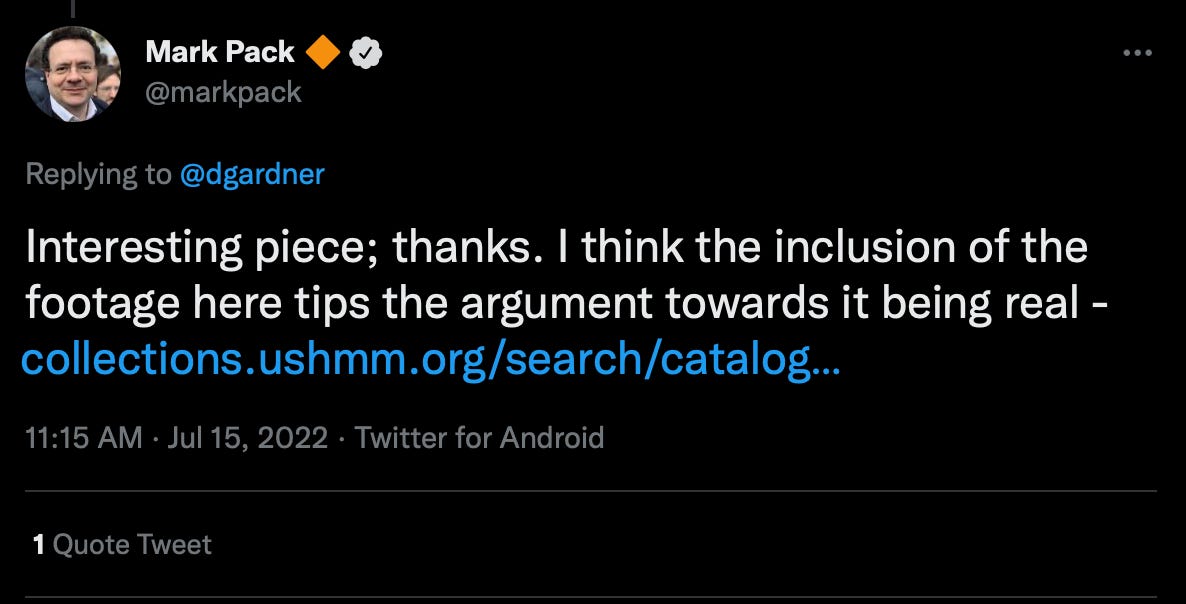Believing Requires More Than Seeing
In a Photoshop world, we need to be more skeptical of images we want to see
Google search data suggest that in most Western countries, a great many people have stopped paying attention to the war in Ukraine. After all, the war began almost half a year ago. In the era of the information firehose, when attention is the most valuable commodity, and children can grow up without ever concentrating on anything for more than a minute, half a year can feel like half a decade did a century ago. Or half a century, at the time of the Hundred Years War.
And that matters because one of the critical frontlines in the war is neither in the east nor the south of Ukraine. It is in the minds of the citizens of Western countries. You can be sure war planners in both Moscow and Kiev study that front intensely, and craft plans for it with as much care as they do artillery duels.
And so I ask you to direct the most precious resource you possess — your attention — to these images of Americans protesting against American involvement in the Second World War in July, 1941, a time when the United States was still neutral but was shipping weaponry to Britain and seemed to be inching toward joining the war on Britain’s side.
If you spend any time on social media, chances are you have already seen these images. They have been shared countless thousands of times by people who support Ukraine and want Western governments to continue, or increase, their arms shipments to that beleaguered country.
And understandably so. These images perfectly encapsulate the arguments being made right now by those who oppose arming Ukraine. When I saw the sign reading “Arm Britain And Prolong the War,” I was agog. Change “Britain” to “Ukraine” and you have the standard argument being made today. That image is a stunningly powerful argument to throw at opponents.
Now I’ll put my cards on the table: I strongly support Ukraine and very much want our governments to send Ukraine everything it needs to break Vladimir Putin’s nose and put an end to his dangerous (and ludicrous) imperial revanchism. And I’m familiar enough with the “America First” isolationist movement that wanted to keep America out of the Second World War, and how widespread that long-forgotten sentiment was at the time, that I was horrified when Donald Trump adopted “America First” as his slogan and his appeal wasn’t undermined in the slightest.
All of which is to say that when I saw the images above, I, too, wanted to hit “retweet.”
Boom! Take that, puerile pacifists and isolationist idiots!
That is how confirmation bias works: Something that contradicts our strongly held views we treat with severe skepticism. We scoff and walk away. Or, less often, we look around furiously for something — anything — we can use to cobble together a rationalization which allows us to … scoff and walk away.
But if the thing confirms what we strongly believe? That is rock-solid evidence. Definitive proof. No need to examine it further, much less think skeptically. Just hold it up and wave it in triumph.
Hit “retweet.”
I came this close to doing exactly that. Even though I know there are many smart people who have good reason to fabricate images like these. And it’s easy to fabricate images like these. I almost hit “retweet” without asking, “where did these images come from? How do I know they are authentic?”
That is five-alarm confirmation bias.
As I’ve said in too many lectures to count, if something contradicts your strongly held belief, there’s no need to worry that you won’t be skeptical enough. You will be. You can’t help but be. It will come automatically, almost effortlessly. In fact, you must beware overdoing it. It’s when the thing supports your beliefs that you should worry: The more the thing supports your strongly held beliefs, the more effort you must make to be skeptical. That’s exhausting. You won’t want to do it. It will feel like a waste of time. But that’s what you must do if you don’t want to fall into the tiger trap.
The nice thing about studying psychology, thinking hard about thinking, and helping others improve their thinking, is that it rubs off. Now and then, I hear my own advice. And now and then — less often than I care to admit — I take it.
I didn’t retweet those images. Instead, I copied them and ran them through image search tools.
The result? They’re all over social media. Twitter, Instagram, Reddit. But all those posts are new.
What about credible sources? And sources published prior to Russia’s invasion of Ukraine? Nothing. Of course, I may have simply missed them, so I can’t be certain. (“I can’t be certain” is a phrase we should all repeat like a mantra.) But it does seem they don't exist. Which is worrisome.
That said, I did find this video on YouTube.
Purportedly of a protest in front of the New York Public Library on July 7, 1941, this would seem to be the source of the still images making the rounds of social media.
So is that the end of the matter? No. For one, the video isn't a newsreel of the sort that was produced by major news-gathering organizations of the day and were presented before movies played in theatres. So I don’t know where it came from. For another, the person who posted it says he heads a Georgian neo-conservative think-tank, and his other posts — Reagan, Churchill — clearly show he has strong views about Russia and Western support for countries targeted by Russia. Which very much includes Georgia.
On the plus side, there is the date. It says it was posted in 2015. And there are comments dating back several years. Can that information be faked? I don’t have the expertise to know. But I’ll decline the tinfoil hat for now and assume that, unless proven otherwise, the date markers are true.
Does that authenticate it? As a good Bayesian, I won’t say “yes” or “no.”
Rather I think it does increase the probability the images are entirely authentic. But I would be cautious about how much I’d raise that probability because of the context of 2015: Russia invaded Georgia in 2008; Russia annexed Crimea from Ukraine and de facto invaded eastern Ukraine in 2014. Hence, in 2015, there were two national governments that had very strong reasons to be concerned with Western popular opinion and whether it supported arming far-away countries to defend themselves against foreign invasion. So motive is established. And means? Even in 2015, changing the wording of signs in a video clip, for example, was challenging but far from impossible.
My best guess? Absent other information, it’s slightly more likely than not that the images are authentic. So they probably are real. But I wouldn’t bet my house on it.
I can understand if you find this inconclusive conclusion dissatisfying. As I’ve written at great length many times, we don’t like uncertainty, so we expect analyses to come to clear, confident conclusions — certain conclusions.
But as I have also written at great length many times, the world we live in routinely does not permit such conclusions. And while it’s psychologically pleasant to believe that we know things with certainty, when in fact we do not, it can be dangerous.
Of course, believing these images are real, if they are not, will do no great harm. But skepticism — in particular, skepticism in the face of confirmation of strongly held beliefs — is a skill that must be cultivated and practiced. And become habitual. Only then can you have any confidence that, when you are faced with something dubious that really does matter — has the CIA found Saddam’s weapons of mass destruction yet? — you will not fall for it.
That’s why it was so disheartening to read the long threads under all those social media posts. No one asked, “where did these images come from? If you don’t know the source, how can we be sure they are authentic?” They just felt the warm glow of confirmation bias and merrily retweeted away.
We’ve really got to do better.
That includes acknowledging one’s own limitations: I am very far removed from being an expert on forensic examination of digital images. If any of you can contribute, please chime in. As always, corrections — even politely worded “you are clearly and entirely wrong” corrections — are welcome.
(PS: Sorry, forgot to mention I also did a newspaper search for a protest matching that description on that date. Came up with nothing. Like a good Bayesian, that raised my eyebrow a little further.)
PPS: A wonderful illustration of the power of the hive mind arrived mere minutes after I posted a link to this piece on Twitter.
A big thanks to Mark Pack. (And please tell me how on earth you found it?)
The link takes you to a very credible source — the US Holocaust Museum — and a surprise. The images apparently come from outtakes of a July, 1941 newsreel. So they are real.
But here’s the surprise: the protest is labelled “most likely staged.” That would explain why I found no news report of a protest that day. And it would put a huge asterisk on that “real.” Let’s call them real-ish.
Reality always finds new ways to surprise.






I appreciated this reflection and wanted to add one little nugget: one reason folks might not feel comfortable asking those questions publicly is the automatic assumption that anyone who asks questions is an enemy of the cause. there are many folks who have such entrenched beliefs, as you said, that when asking questions and clarifying sources and seeking to inform ourselves, rather than just taking the internet’s word for it, you’ve got to be prepared to defend yourself, even if you’re aligned in principle with the speaker.
Hope that makes sense. Friday afternoon and on my second coffee but it doesn’t seem to help. 😂
Great article. We have to constantly remind ourselves that our biases get in the way of understanding the truth. I really like the Bayesian reminder to think in terms of probabilities, rather than black and white.